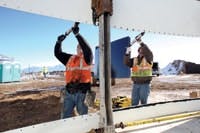In recent years, The Dannon Co. has experienced increased demand and significant sales growth in its most popular yogurt product lines, including consumer favorite Activia. In March 2010, the company’s CEO said that Dannon could record double-digit growth in the U.S. on a long-term basis, potentially doubling consumption per capita in four years.
In response, the company focused on ways to increase supply to meet customer demand by expanding its West Jordan, Utah, production facility. Preliminary feasibility studies ruled out the possibility of simply expanding and updating the existing 2,700-sq-ft pretreatment facility. The plant’s wastewater pretreatment system was nearly at capacity and incapable of accommodating future growth, therefore, municipal wastewater treatment plant officials requested that Dannon include wastewater pretreatment expansion as part of its plans. Dannon determined that constructing a new wastewater facility would be the most effective pretreatment solution. It would be designed to pretreat the plant’s wastewater prior to being discharged to the local municipality and enable Dannon to meet long-term production demands.
Tight Timeline
The multiple steps associated with producing and packaging yogurt dictated a short time frame. For example, yogurt production and packaging equipment had to be ordered before the facility’s design and construction. A rigid six-month timeline was set to ensure that the new wastewater treatment facility and increased yogurt production capacity would go online at the same time.
Dannon determined it needed an accelerated design-build delivery method to ensure that the wastewater project would be completed at the same time as all other production-related projects.
According to a study conducted by the Water Design-Build Council, “Independent Comparative Evaluation of Design-Build vs. Conventional Design-Bid-Build Project Delivery for Municipal Water and Wastewater Facilities,” using the design-build delivery method enables water and wastewater projects to come in ahead of or on schedule more often than traditional methods, as well as be delivered at or below the owner’s budget almost twice as often with no significant difference in quality.
Dannon selected Colorado-based MWH Constructors to design and construct the wastewater pretreatment facility due to the global engineering firm’s design-build wastewater industry experience and a close working relationship between
its engineers and contractors. Prior to starting the construction contract work in late August 2010, MWH completed preliminary engineering of the wastewater pretreatment facility, including the sizing and layout of treatment units. Additionally, the MWH team identified the design-build opportuni- ties to expedite the design, construction and operations of the pretreatment facility.
The primary treatment process selected was a moving bed bioreactor (MBBR) combined with dissolved air flotation (DAF), which includes the pretreatment facility, odor control facilities, pumping, tanks, treatment and storage. The MBBR process was selected because it reduces the volume of biological reactor basins required as compared to conventional treatment systems. By using plastic biological carriers, MBBR systems increase the total biological component of the reactor, which is also helpful when dealing with high strength wastewater, such as that produced by yogurt manufacturing.
Overall, the system requires less space and fewer controls than other biological systems, while meeting discharge requirements and handling a flow of several hundred thousand gallons per day. The Dannon plant was the first in Utah to use MBBR.
Addressing Challenges as a Team
MWH and Dannon worked closely together to develop design and construction solutions and address issues quickly. Project challenges naturally arose, many of which threatened to derail the established six-month timeline.
The first challenge was permitting, which tends to be a long process under normal circumstances, let alone under a tight time frame. In addition, the design-build process was new to some city officials and there was not any other pretreatment facility of the planned size and scope in West Jordan. MWH worked closely with city officials, obtaining permits on a provisional basis, as the design work became available. Construction started on Nov. 1, 2010, following approval of an amended site plan, conditional use permit and land disturbance permit. All remaining permits were obtained within 45 days of commencement of work.
Utah’s winter weather conditions also posed a challenge. Just after construction started, temperatures at the site plunged to daytime highs of 5°F, and snowfall was a regular concern. Accordingly, the design-build plan called for completing the foundations and building shells as quickly as possible to provide a space that could be heated. This also facilitated timely construction of the electrical and mechanical systems required for the project.
The Dannon facility also happened to be located near a drinking water well, thus prompting additional action to be taken to address any environmental concerns. MWH protected the water source with enhanced storm water containment and berms around the site.
Saving Time & Money
The collective team of construction, structural, mechanical and electrical professionals worked in a small, onsite construction office to deliver the finished project on time and under budget. Together they were able to identify several methods of construction that helped save Dannon time and money during the six- month project period. The design team was fully engaged in the entire construction process, allowing for quick decisions on any proposed changes and design modifications. The construction team typically would plan out work several days ahead to identify potential issues, giving the design team enough time to provide a rapid response to the issues identified and to reissue drawings incorporating any modifications.
The project required startup by March 15, 2011. Thanks to an accelerated design-build delivery method, the pretreatment facility began receiving water one day before the deadline. In the short amount of time available, three steel tanks; a 6,500-sq-ft building; two DAFs; and an air supply system (blowers and diffusers with required stainless steel piping) were completed. Chemical supply systems initially were fed through a temporary system, but later were incorporated on a permanent basis following the facility’s startup.
The facility was fully completed in June 2011 and included all control, mixing and electrical systems, along with site paving.
Download: Here


